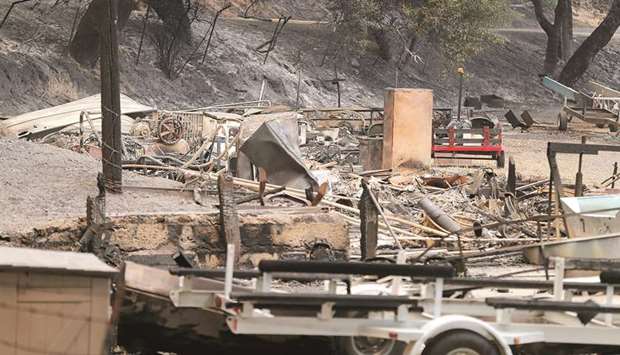Summer in the American West. The time of flip-flops, river rafting, mountain fishing and Frisbee on the beach. But increasingly, also a time of stepping into our backyards and lifting our noses to sniff for smoke. For watching the flags atop the bank or outside city hall to see how hard the wind is blowing.
Or if we’re especially unlucky – and we’ve been unlucky a lot in the last decade – for packing precious bits and pieces of our lives into boxes and stacking them beside the front door, ready to load into the car should word come down that wildfires are closing in; that it’s time to evacuate. Indeed some of us are right now in the worst of it all over again: In Breckenridge, Colorado. In California’s Yolo County. In British Columbia.
From the Rockies to the Pacific, the last 16 years have brought an astonishing 11 summers with more than a dozen so-called mega-fires, defined as a single burn engulfing more than 100,000 acres. More to the point of our anxieties, about 120mn of us are living on some 200mn acres considered to be at high risk of burning. We’re living our lives, as will our children and our grandchildren, in a land of flames.
The problem is partly the result of 80 years of over-aggressive fire suppression, beginning in the early 20th century. Because of the arid nature of the West, when trees die, the primary way they decompose is through fire. Putting out every burn we could get to played well to the “conquer the foe” aspect of our national character, but it also eliminated the fairly regular, altogether natural “maintenance fires” that kept the forest healthy.
Which leaves us today with hundreds of millions of acres of forest burdened with unnaturally heavy fuel loads. Understandably, many wildfire experts are pushing hard for “treatments” that involve either thinning or prescribed burning. Yet one of the agencies primarily responsible for such work, the US Forest Service, continues to drain its budget in the actual fighting of fires. In several years since 2000, the Forest Service has spent 500 times more on suppression – about $2.5bn – than on prevention.
To make matters worse, our past forest management mistakes are running smack into climate change. In a groundbreaking study published last fall, researchers at Columbia University and the University of Idaho quantified the effect of human-caused climate change on wildfire activity: Since 1985, global warming has nearly doubled the annual number of acres burning in the western United States.
Faster melting snowpacks and increased warmth in the fall have grown the fire season by a staggering 75 days since 1972. The increased heat, along with profound drought have routinely stressed trees – killing many outright or leaving them vulnerable to lethal beetle infestations. In 2016 alone, it’s estimated that more than 60mn trees died in California.
And now, the deluded Trump administration has yanked us out of the Paris climate accord and begun the process of opening more Western lands, seas and forests to oil and coal development. This, when we should be doing all we can to end our carbon-emitting ways.
A different but equally dangerous delusion infects America’s worst wildfire zones. According to the International Association of Wildland Fire, only about 3 percent of the 70,000 communities in those zones have taken steps to make their neighbourhoods “fire-wise.” Simple measures such as creating non-flammable 5-foot landscape zones around homes, cleaning gutters and covering attic vents with wire mesh to block blowing embers can make a difference. County governments in wildfire areas should mandate at least 30ft between houses to help prevent house-to-house ignition, and the installation of adequate on-site water supplies for firefighters.
In the winter of 2016-17, near record-breaking rains and snow relieved the drought in some parts of the West. Wildfire experts recognise the generous rainy season as a blessing, but not a cure. Although holdover moisture in trees and big shrubs may keep some fires in check, when the thick mats of grasses created by all that moisture dry out in late summer, it will create conditions in which fires can ignite easily and spread rapidly. From January through June in California, despite its wet winter, twice as many acres had burned compared with last year.
Without a doubt, Westerners will be in the news in the coming weeks – clutching our loved ones and watching our homes go up in smoke. You’ll see the tragic shots of smouldering backcountry tracts and houses burned to their foundation, right after the clips of firefighters, who will be cast, deservedly, as the heroes of this story.
For most of my life I grew up thinking of summer as a time for optimism, a notion I still haven’t entirely shaken. I don’t hope for an end to the flames – they come with the territory, after all. But I do hope we rise from the inevitable ashes determined to bring humans and fire into better balance, to mitigate the self-inflicted danger of climate change, as well as to make sound forest practices a priority in the federal budget. If the beginning of another burning season offers harsh reminders of the mistakes we’ve made, it also prompts us to create a more sustainable future for all the Western summers yet to come.

The remains of a structure and boats scorched by the Whittier Fire along SR-154 in the Los Padres National Forest near Lake Cachuma, Santa Barbara County on Sunday. At least 200 people were evacuated from a remote area east of Santa Maria. Wildfires continued to rage across California amid a record-breaking heatwave.


